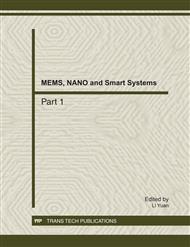p.618
p.625
p.634
p.640
p.646
p.651
p.656
p.663
p.670
Amorphous Carbon Thin Films Deposited by Thermal CVD Using Camphoric Carbon as Precursor
Abstract:
This paper reports on the deposition of semiconducting amorphous carbon (p-aC) films fabricated onto the glass substrate and n-type silicon by Thermal Chemical Vapor Deposition (CVD) using natural source of camphoric carbon as the precursor material. Those samples were deposited at 5 different temperatures from 3500C to 5500C. From the characterization of the electrical properties using current-voltage (I-V) measurement, I-V graph was modeled for both conditions, where for a-C thin films linear graph (ohmic) were performed, whereas for the device, a rectifying graph were obtained. The analyze revealed that conductivity shows an increment as deposition temperature increased, both in dark and under illumination condition. On the other hand, the solar cell device of the p-aC/n-Si achieved an efficiency of 0.1111% for the a-C deposited at 3500C. Other than that, optical properties were also characterized by using UV-VIS-NIR system. The same trend of optical and electrical can be seen when the measurement from the Tauc’s plot expose a decreasing value of optical band gap as temperature increase.
Info:
Periodical:
Pages:
646-650
Citation:
Online since:
November 2011
Authors:
Price:
Сopyright:
© 2012 Trans Tech Publications Ltd. All Rights Reserved
Share:
Citation:


